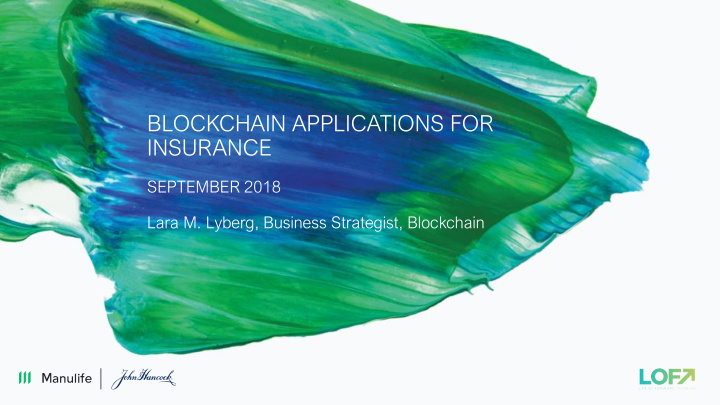



BLOCKCHAIN APPLICATIONS FOR INSURANCE SEPTEMBER 2018 Lara M. Lyberg, Business Strategist, Blockchain
AGENDA Blockchain Overview • Insurance Use Cases: Opportunities and Challenges • Industry Consortia: Where We are Participating • Q&A • For Educational Purposes Only
BLOCKCHAIN OVERVIEW For Educational Purposes Only
BLOCKCHAIN: WHAT IS IT? • A new type of database • Distributed ledger technology (DLT) is a consensus of replicated, shared and synchronized digital data • Blockchain, a type of DLT, is comprised of immutable digital data in groups called “Satoshi Nakamoto” blocks • Started with a paper by an unidentified author in October 2008 • Based upon concepts developed from the 70’s and forward http://www.blockchaintechnologies.com/blockchain-definition https://digitalasset.com/faqs.html For Educational Purposes Only
BLOCKCHAIN ACTS AS THE TRUST LEDGER OF THE Blockchain INTERNET Internet Age IT Supremacy ? Trust Logic promises transparency between users Network Logic enables 2015 communication between users 1994 Transition from paper to digital capabilities 1980 Mougayar, William. The business blockchain: Promise, practice, and application of the next Internet technology. Hoboken, NJ: John Wiley & Sons, Inc., 2016. Print. For Educational Purposes Only
HOW WILL BLOCKCHAIN AFFECT BUSINESS? Accounting for Value Exchanging Value Moving Value Decreases settlement time & cost Real-time, transparent Lower cost & faster transactions audit & financial reporting Lending Value Funding & Investing Authenticating Value & Identity Peer to peer lending Raising money & investing Intermediaries no longer needed without intermediaries Storing Value Insuring Value & Managing Risk Individuals may not need to rely More comprehensive reputation on banks if it can be stored on the scores blockchain For Educational Purposes Only
SMART CONTRACTS FOR TRUSTLESS COMPUTATION Sm Smar art t Co Cont ntract ract “A computer protocol intended to digitally facilitate, verify, or enforce the negotiation or performance of a contract. Smart contracts allow the performance of credible transactions without third parties.” https://en.wikipedia.org/wiki/Smart_contract For Educational Purposes Only
CONSENSUS IN PUBLIC BLOCKCHAINS Minin Mi ing g and d Proof of of Work A user makes a transaction, which is A miner validates all If the miner wins consensus, transactions to prevent added to a memory pool of a node. then its validated block is double-spending and bundles added to the node’s them into a block. The miner blockchain, and all nodes in the then runs the consensus network are updated. mechanism, in this case, proof of work. • http://tech.eu/features/808/bitcoin-part-one/ • Nick Emmons, Blockchain Developer For Educational Purposes Only
CONSENSUS IN PERMISSIONED NETWORKS Practic ctical al Byzantine zantine Fault ult Tolerance erance Practical Byzantine Fault Tolerance enables a system to withstand errors from not more than 1/3 of nodes without compromising the integrity of data. The Byzantine Generals’ Problem refers to coordinating a dispersed army amidst traitors. Microsoft, 1982, The Byzantine Generals Problem, https://www.microsoft.com/en-us/research/publication/byzantine-generals-problem/ For Educational Purposes Only
TWO MAIN TYPES OF BLOCKCHAIN USE CASES Mu Mutua uali lize zed d Data ta • Multilateral B2B workflows where each participant independently validates each other’s data accuracy and/or processes • Industry utilities that would benefit the industry's players and avoid the challenge of ownership • Replace an otherwise adequate centralized solution to de-risk central points of failure from cybercrime For Educational Purposes Only
TWO MAIN TYPES OF BLOCKCHAIN USE CASES Tokeni eniza zation ion “Intrinsic” or “native” or “built - in” tokens, which are made -up resources that have some utility, such as: • Block validation incentives, also known as miner rewards • Transaction spam prevention, since if all transactions cost some token, it limits the ability to spam • Asset-backed tokens, which are claims on an underlying asset from a specific issuer Fund nd s Token en s For Educational Purposes Only
INSURANCE USE CASES: OPPORTUNITIES AND CHALLENGES For Educational Purposes Only
MASTER DEATH FILE FOR LIFE INSURERS Today Block ockchain chain SSA SSN Death Physician’s Master File Physician’s Funeral Statement Life Insurer Statement Director Beneficiary Life Insurer Beneficiary Faster, Payment Automated Funeral Payment Director State Health Department https://www.cognizant.com/whitepapers/blockchain-a-potential-game-changer-for-life-insurance-codex2484.pdf For Educational Purposes Only
CHALLENGES • Identifying suitable use cases and partners requires collaboration and business and blockchain knowledge • Legal precedence and regulatory guidance are limited in certain areas of blockchain • Insurance companies must meet stringent compliance requirements while exploring new blockchain capabilities • Financial institutions face reputation risk if technology exploration proves too risky • Technology integration requires roadmap planning and blockchain training For Educational Purposes Only
WHERE WE ARE PARTICIPATING For Educational Purposes Only
THANK YOU Please feel welcome to contact me at Lara_Lyberg@JHancock.com For Educational Purposes Only
Recommend
More recommend